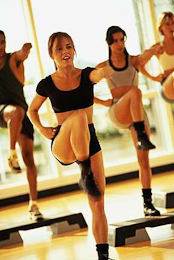Aerobics Workout
By definition, the purpose of an aerobic workout is to improve the body's oxygen consumption since the word 'aerobic' means 'with oxygen.' Aerobic exercise was developed chiefly by Kenneth Cooper M.D. and Pauline Potts. Their goal was to find out why many athletes with great muscular strength had trouble with long distance events. Their findings suggested that increasing oxygen consumption should help solve this problem. Generally, aerobic exercises are performed for extended periods of time at a moderate energy level. In addition to improving oxygen flow, athletes will find that participation in aerobics increases flexibility, core strength, and cardiovascular fitness. Some aerobic exercises can be done without equipment, however many athletes do use equipment to aid their exercise. Treadmills can be used for people who do not have the space to jog, run, or walk. Cross trainers, stationary bikes, and other commercial exercise equipment is also available to aid aerobic exercise. Cost: $30 to $500 Depending on your chosen aerobic activity, your costs can be as low or high as your budget allows. Walking is likely the least expensive aerobic activity (only requiring comfortable shoes and the occasional replacements). Activity Locations: Almost Anywhere You may choose to ride a stationary bike at the gym/home or walk around your neighborhood -- variety is one of the best motivational tools. Types of MovementsThe most efficient aerobic workouts include a warm up, a 20 minute workout, and a cool down period. The number of different forms of aerobic routines is immeasurable. Generally, it is done in a class setting although it can be done alone. Often it involves dance-like motions which keep the body moving at a moderate energy level. It is usually accompanied by music for both rhythm and to keep the energy level up although music is not necessary. Jogging, running at a moderate pace, swimming, and jumping rope are all considered aerobic exercises as well. Participating in an aerobic workout strengthens the muscles used to breathe which improves the athlete's airflow. The heart is also strengthened. Depending on which workout the athlete does, muscles all over the body will become toned. Also, blood flow through the muscles is increased which allows for a better flow of oxygen with increased endurance as a result. Muscles will also recover faster from intense use. Mental and Physical RequirementsMost people can engage in aerobic activity of some form -- even walking has enormous physical and mental benefits. It's important, however, to check with a health professional before engaging in physical activity designed to increase heart rate. Certain heart conditions can make some aerobic activity dangerous. Morbidly obese individuals must focus on small steps toward physical fitness before launching into a full aerobic routine, both for motivational and safety reasons. Equipment Requirements
Mental and Physical BenefitsMental
Physical
Aerobic EffectAchieving an 'aerobic effect' is generally thought of as an increased heart rate during the time one is exercising. Aerobics are excellent at achieving this effect. Usually while doing aerobic exercise, the athlete will used 70 to 80% of his or her maximum heart rate capacity. This is much greater than during a warm up which usually only requires 50% of the maximum heart rate capacity or when not exercising. Aerobic exercise has numerous health benefits. The number of blood cells in the body is increased which allows the body to consume more oxygen. 
Blood circulation is also improved and blood pressure reduced. Cardiovascular risks are lessened due to the strengthening of the heart muscle. Aerobic exercise can also stimulate bone growth which can help people avoid osteoporosis. It is also an effective way to lose weight. Many experts state that aerobic exercise is the fastest exercise based way to loose weight. Since the heart rate is in the 70 to 80% range, the body burns more fat than it would during anaerobic exercise which burns glucose, which is useful for energy bursts, but not as useful for weight loss. Aerobics can also improve self esteem. |
Copyright © 2025 FitnessHealth101.com All Rights Reserved
FITNESS TOPICS
FITNESS REVIEWS
FITNESS & HEALTH GLOSSARIES

